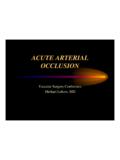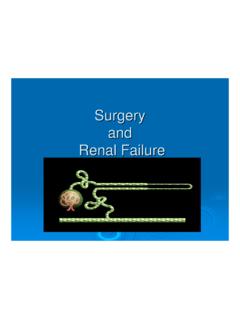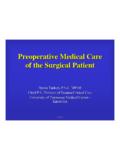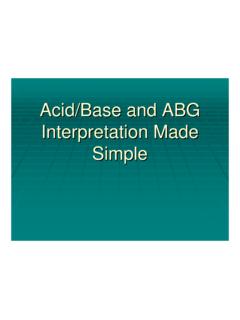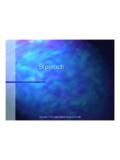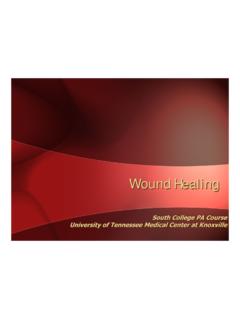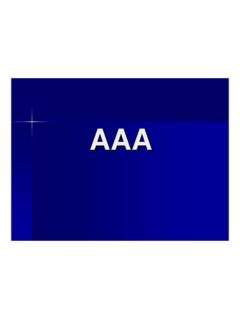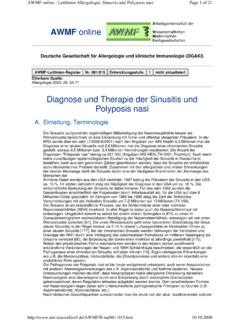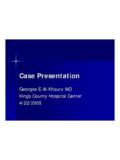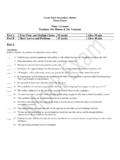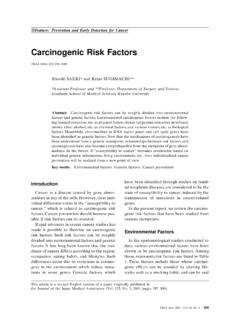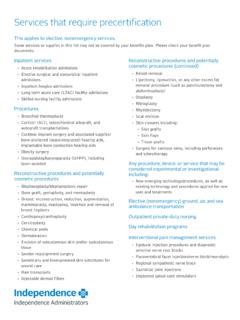Transcription of Colon, Rectum, and Anus - The University of …
1 Colon, rectum , and anus South College PA Surgical Course Colon and rectum Terminal portion of GI tract Two functions Absorption of water, electrolytes Storage of feces Biologically not essential Disease is very common Anatomy Multiple parts Retroperitoneal and peritoneal portions External longitudinal muscle layers teniae coli rectum 15 cm, external layer continuous anus 3-4 cm from dentate line to anal verge Above dentate line--insensate Anatomy Blood supply to colon from superior and inferior mesenteric arteries Junction relatively poor blood supply rectum three sources IMA, internal iliac, internal pudendal Venous drainage of rectum to IMV/portal and to systemic circulation Connected by venous cushions--rrhoids Diagnosis Digital rectal exam Endoscopy routine after 50, q 3-5 years Abdominal series pneumoperitoneum, obstruction.
2 Volvulus Contrast studies CT scan Angiography/nuclear study Terminology Ostomy external opening Colostomy, ileostomy Distal segment Mucus fistula, Hartmann's pouch, loop -ectomy resection Colectomy, proctocolectomy, abdominoperineal resection (APR), low anterior resection Diverticular Disease True diverticula all layers, rare in colon Acquired (false or pseudo-) diverticula . mucosal herniation through muscle Related to diet, straining, age Diverticulosis presence of diverticula Diverticulitis infectious process Diverticulosis Multiple false diverticula of colon Most commonly in sigmoid 80% asymptomatic finding on BE, other study Symptoms LLQ pain, change in bowel habits, bleeding Treatment high fiber diet Diverticulitis Obstructed, infected diverticula Micro or macro perforation 1/6 of patients with osis will have itis Pain, change in bowel habits, possible mass, fever, white count.
3 Peritoneal signs Complications 44% perf or abscess, 8% fistula, 4%. obstruction Diagnosis CT, BE, scope later Treatment antibiotics, hydration, NPO. Surgery for severe complication or repeated bouts Fistula formation Colovesical most common (4%). UTI, fecaluria, pneumaturia Other causes cancer, Crohn's, radiation, trauma Diagnosis contrast BE, cysto, IVP, methylene blue Treatment--surgical Diverticular Bleeding Bleeding primary symptom in 5-10%. Occasionally massive (>4 units in 24. hours). Bleeding distal to Ligament of Treitz 70%.
4 Diverticular, 25% is massive Differential angiodysplasia, solitary ulcers, varices, cancer, rarely IBD. Diagnosis endoscopy, angio Colonic Polyps Inflammatory polyps (pseudopolyps) IBD. Hamartomas (juvenile polyps, Peutz-Jehgers syndrome) benign, may regress Adenomas premalignant, esp. >2-3 cm Tubular-7%, tubulovillous-20%, villous-33%. Pedunculated on stalk, remove by scope Sessile (flat)-remove surgically Familial polyposis or Gardner's syndrome total abdominal colectomy, mucosal proctectomy, ileoanal pullthrough Colon Cancer 55,000 deaths annually 140,000 new cases each year More occur on lower left side?
5 Synchronous (simultaneous) in 5%. Metachronous (second develops after resection). in 3-5%. Peak at 70, start in 4th decade Familial polyposis, Gardner's, UC, Crohn's, polyps Colon Cancer 5 year survival 60%. Effective screening Effective screening strategies, based on risk Mild risk factors age, diet, physical inactivity, obesity, smoking, race, alcohol Intermediate risk factors personal history of colon cancer or adenoma or strong family history High risk factors familial polyposis, Gardner's, patients with UC or Crohn's for > 10 years Screening Mild Risk Beginning at age 50, one of below.
6 Yearly fecal occult blood test plus flexible sigmoidoscopy q 5 years Flex sig q 5 years Yearly fecal occult blood test Colonoscopy q 10 years Double contrast BE q 5 years Screening Greater Risk Intermediate risk Begin at 40. Do more frequently q 3-5 years High risk function of duration Blood tests for familial polyposis, HNPCC. Screening begin in teens UC/Crohn's for 10 years, annual colonoscopy Consider prophylactic total colectomy Colon Cancer Signs and Symptoms Right-sided occult blood loss, anemia Left-sided obstruction, macro bleeding Rectal bleeding, obstruction, alternating diarrhea and constipation Change in bowel habits and/or bleeding: Rectal exam, occult blood test BE or colonoscopy Colon Cancer Preop Evaluation Colonoscopy synchronous lesions CT-- + or.
7 CEA blood test Treatment surgery to remove primary, evaluate extent of spread, allow staging and plan further therapy Colon Cancer--Staging Dukes-Astler-Coller System TMN Staging Both evaluate extent of penetration through colon, nodal involvement, and distal mets Adjuvant chemotherapy 5FU, others Radiation, especially in pelvis Staging AJCC/TNM Dukes Astler-Coller 0. I A A, B1. IIA B B2. IIB B B3. IIIA C C1. IIIB C C2, C3. IIIC C C1, C2, C3. IV D. Colon Cancer--Followup Curative resection, no adjuvant therapy indicated Monthly exam, bimonthly CEA, scope or BE q 6 months for first two years PET scan CT scans IBD Ulcerative Colitis Mucosa and submucosa of colon and rectum Bimodal distribution 2/3 occur at 15-30, remainder at 55.
8 10/100,000 population Family history in 20%. rectum involved in >90% with proximal extension Ulcerative Colitis Presentation variable Watery diarrhea with blood, pus, mucus Cramping, abdominal pain, tenesmus, urgency Weight loss, dehydration, pain, fever Fulminant toxic megacolon, sepsis, shock Extraintestinal signs: ankylosing spondylitis, peripheral arthritis, uveitis, pyoderma gangrenosum, sclerosing cholangitis, pericholangitis, pericarditis Complications: toxic megacolon, colon perforation, massive hemorrhage, anorectal complication, cancer IBD Crohn's Disease Transmural disease, anywhere in GI tract Minority limited to colorectal Also bimodal distribution Commonly in terminal ileum Differs from UC: rectal sparing, skip lesions, aphthous sores, linear ulcers Colon Obstruction 10-15% of intestinal obstructions Most commonly sigmoid Adenocarcinoma 65%, diverticulitis scarring 20%, volvulus 5%.
9 Inflammatory disorders, benign tumors, foreign bodies, fecal impaction Adhesive bands rare in colon Colon Obstruction Presentation abdominal distention, cramping abdominal pain, nausea and vomiting, obstipation Radiographs distended proximal colon, air-fluid levels, no rectal air Barium enema or scope may define area of obstruction IV fluids, NPO, NG suction Emergent lap for cecum > 12 cm or peritoneal signs Colon Obstruction Ogilvie's syndrome nonobstructive dilation Volvulus rotation on axis of mesentery 5-10% of large bowel obstructions Sigmoid 70%.
10 Cecal 30%. More common in elderly Cecal Volvulus Sigmoid Volvulus anus and rectum Pain, protrusion, bleeding, discharge Everyone complains of hemorrhoids Must examine, but be gentle Inspection fissures, skin tags, hemorrhoids, fistulae, tumors, dermatologic or infectious conditions Digital exam tumors, polyps, sphincter weakness Rectal Prolapse Procidentia Full thickness intussusception of rectum through anal opening More common in thin women Symptoms rectal pain, mild bleeding, incontinence, mucous discharge, moisture Hemorrhoids Precipitated by constipation, straining, pregnancy, increased pelvic pressure (ascites, tumor), portal hypertension, diarrhea Found in 3 positions.

